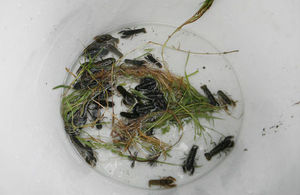Safe ark for threatened Norfolk white-clawed crayfish
An endangered population of white-clawed crayfish have been released into the headwaters of a river in north Norfolk.

These small white clawed crayfish have been moved to safety
On 17 September Environment Agency and partner organisation volunteers caught 300 white-clawed crayfish from a population at risk from the invasive non-native American signal crayfish.
They released them to safety into the headwaters of the River Glaven.
Signal crayfish carry a disease that kills white-clawed crayfish and has caused local extinctions. They also compete with white-clawed crayfish for food and burrows and may even eat the white-clawed crayfish.
Amy Prendergast, Environmental Monitoring Officer for the Environment Agency said:
It was great to see so many people getting hands on in catching and measuring the crayfish ready to be moved to their new home. We hope that they will thrive in the gravelly stream for many years to come.
The signal crayfish and the new population of white-clawed crayfish will be separated by a number of sluices which act as a physical barrier that slows the upstream spread of crayfish. The signal crayfish in the lower river may take decades to reach this site, and in the meantime ongoing research will hopefully find a way of controlling signals in the future.
Over the next five years the new site will be surveyed to check whether the new population of white-clawed crayfish are breeding and doing well. It is thought that the white-clawed crayfish were present in this location until the 1970s when they may have been wiped out by a pollution incident.
This is part of a longer term project to help conserve the white-clawed crayfish, to populate ark sites through an annual co-ordinated day of action.
Notes to editors:
The partnership works to conserve white-clawed crayfish in Norfolk, Suffolk and Essex. Organisations involved included the Environment Agency, Norfolk Rivers Trust, Norfolk Biodiversity Partnership, Norfolk Non-Native Species Initiative, River Glaven Conservation Group, Norfolk Wildlife Trust and University College London. This is the fourth year of translocating crayfish at risk to safe Ark sites.
The public can help to protect the white-clawed crayfish by following the Environment Agency’s advice to check, clean and dry. This will prevent the spread of non-native diseases, plants and animals.
http://www.nonnativespecies.org/checkcleandry/
Sightings of crayfish can be sent to angeast.frb@environmnet-agency.gov.uk with a photograph. Or you can use the Aqua Invaders app http://naturelocator.org/aquainvaders.html
The public must never transfer a crayfish to a new location without the permission of Natural England and the Environment Agency. It is an offence under the Wildlife and Countryside Act 1981 (as amended) to spread signal crayfish and other non-native species which is subject to a fine of up to £5000 or a prison sentence of up to 6 months.